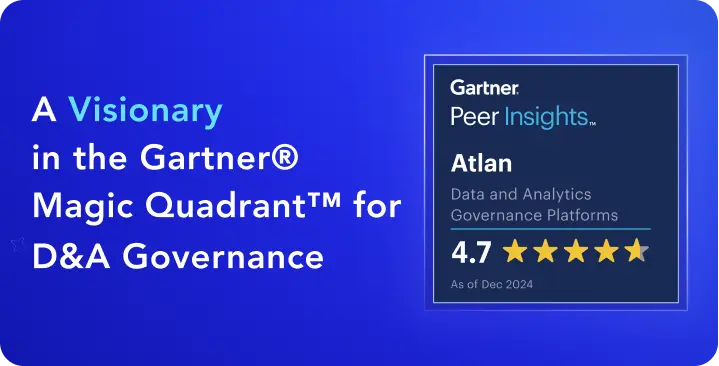How to Implement a Data Discovery Tool With BigQuery?

Share this article
Integrating a data discovery tool with BigQuery enhances analysis of large datasets. It uncovers key insights for strategic decisions and process improvements, leveraging BigQuery’s scalability and advanced analytics features.
As a serverless and scalable platform, BigQuery facilitates the collection, processing, and analysis of large datasets - essential for identifying trends and insights in data discovery. BigQuery’s features like machine learning, geospatial analysis, and BI tool integration align with the goals of data discovery to provide actionable business intelligence.
It addresses common data discovery challenges like data integration, quality, and scalable infrastructure, making it an effective tool for organizations to efficiently extract valuable insights from their diverse data sources.
Modern data problems require modern solutions - Try Atlan, the data catalog of choice for forward-looking data teams! 👉 Book your demo today
Table of contents #
- Why should you use a data discovery tool with BigQuery?
- BigQuery overview
- What is data discovery?
- Steps to implement a data discovery tool with BigQuery
- Guidelines for effective implementation
- Data discovery for BigQuery: Related reads
Why should you use a data discovery tool with BigQuery? #
Implementing a data discovery tool is crucial for several reasons:
- It enhances decision-making by providing insights from diverse data sources.
- Facilitates the identification of trends and patterns, aiding strategic planning.
- Improves efficiency by automating data analysis and reducing manual effort.
- Encourages a data-driven culture, fostering innovation and informed choices.
BigQuery overview #
BigQuery is Google’s fully managed, serverless data warehouse, enabling scalable analysis over petabytes of data. It’s a Platform as a Service (PaaS) supporting SQL queries and includes built-in machine learning capabilities.
Additionally, BigQuery includes built-in machine learning capabilities, allowing users to create and execute machine learning models directly within the database using simple SQL queries. This integration of machine learning and analytics simplifies the process of deriving insights from large datasets, making it more accessible to both data scientists and analysts.
What is data discovery? #
Data discovery involves collecting and evaluating data from various sources, primarily to discern trends and patterns. This process is integral to business intelligence, assisting in making informed business decisions by analyzing disparate, siloed data sources.
It encompasses multiple steps: connecting to numerous data sources, data cleansing, and preparation, sharing data across an organization, and performing in-depth analysis to derive insights that inform business processes.
Steps to implement a data discovery tool with BigQuery #
Implementing a data discovery tool with BigQuery involves the following strategies:
1. Evaluating tools for data discovery in a BigQuery environment #
- Performance & scalability: Assess how well the tool scales with large datasets and integrates with BigQuery’s serverless architecture.
- Data integration: Verify the tool’s ability to integrate with diverse data sources, a key aspect of BigQuery’s environment.
- Cost management: Choose tools that offer cost-effective solutions without compromising on functionality.
- Security features: Look for tools with robust security measures that complement BigQuery’s IAM security infrastructure.
- Advanced analytics: Choose tools that leverage BigQuery’s machine learning and geospatial analysis capabilities.
- User experience: Evaluate the ease of use, especially for teams accustomed to BigQuery’s interface and functionalities.
2. Missed aspects during evaluation #
- Overlooking long-term scalability: Ensure the tool can handle growing data needs.
- Ignoring hidden costs: Be aware of additional costs like data transfer fees.
3. Making a business case #
- Cost-benefit analysis: Highlight the financial and operational efficiencies gained.
- ROI projection: Estimate the return on investment by analyzing the potential cost savings and efficiency gains from implementing the data discovery tool.
- Alignment with business goals: Show how the tool aligns with strategic objectives.
- Risk mitigation: Emphasize how the tool mitigates risks associated with manual data processes and decision-making.
Guidelines for effective implementation #
Common pitfalls in implementing a data discovery tool with BigQuery include:
- Underestimating the complexity of integrating multiple data sources.
- Overlooking the cost implications of large-scale data processing.
- Neglecting the optimization of data schemas for efficient querying.
- Failing to fully leverage BigQuery’s machine learning and advanced analytics features.
- Inadequate training or support for users adapting to BigQuery’s environment.
Dataplex as a data discovery tool #
Dataplex is a service from Google Cloud designed for managing, securing, and governing data across various environments like data lakes, data warehouses, and databases.
While Dataplex itself isn’t specifically a data discovery tool, it enhances data discovery by organizing and streamlining access to data stored in different systems, including BigQuery.
For data discovery with BigQuery using Dataplex, the process involves leveraging Dataplex’s ability to unify and govern your data. This unified management ensures that data in BigQuery is well-organized, making it easier and more efficient to locate, access, and analyze specific datasets within BigQuery. Essentially, Dataplex helps maintain the data in an optimal state for discovery and analysis, improving the overall efficiency and effectiveness of data discovery in BigQuery.
Data discovery for BigQuery: Related reads #
- BigQuery Documentation
- Data Discovery: Definition, Purpose, Process, Techniques, and Tools
- Data discovery catalog
- How to Improve Data Discovery with Persona-Driven Strategies
- Data Discovery Tools: 9 Popular Tools You Should Consider in 2024
- How to set up Google BigQuery
- How to crawl Google BigQuery
- Metrics catalog for BigQuery
Share this article











